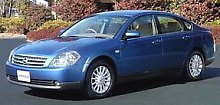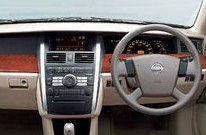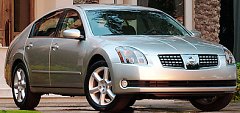 With
the introduction of Teana (or Cefiro in some countries), Nissan has
completed its simplification
process
of its once overcrowded model lineup in Japan. The successor to Cefiro
has thrown away its own platform and now shares the FF-L (front-engine,
front-wheel-drive, large) platform with the American-market Altima. By
the way, this platform also gives birth to the American Maxima. With
the introduction of Teana (or Cefiro in some countries), Nissan has
completed its simplification
process
of its once overcrowded model lineup in Japan. The successor to Cefiro
has thrown away its own platform and now shares the FF-L (front-engine,
front-wheel-drive, large) platform with the American-market Altima. By
the way, this platform also gives birth to the American Maxima.
FF-L uses strut suspensions up front and multi-link at the rear, the latter ensures better bump absorption and quietness than Cefiro’s non-independent beam-axle. However, no matter the setting of suspensions and choose of tyres favour ride comfort rather than handling, as Teana is tuned to please traditional customers in Japan. People who prefer European-style handling had better to buy Skyline / Infiniti G35 instead.
With a wheelbase of 2775mm, Teana is a big car in Japan and would have been considered as an executive car in Europe if it were there. Very tall people may find the swoopy roof limiting rear headroom, but otherwise all passengers enjoy good space in all direction. Comfy seats are flat thus not designed for hard cornering, just like the car itself.
Of course, 3500cc could be too much for most Japanese - most of their cars are below 2000cc, therefore Nissan also offer a 2.3-litre version of the VQ engine. It pumps out 173 horsepower. This engine is coupled to a 4-speed automatic only, unlike the 3.5's Xtronic CVT (Continuous Variable Transmission). Xtronic is a conventional CVT using steel belt, like that used by Primera for years. However, it is strengthened to handle the higher torque of the big V6 while transmission ratio range is widened to improve acceleration and fuel economy. The
problem of Teana is that it is not outstanding in any area. A Lexus
gives
you impression of quality and refinement, a Volvo shines in comfort, a
BMW or Audi scores high in driver excitement. In contrast, Teana seemed
a mixture of all the mass production components without a focused
character.
Nissan wants to sell 100,000 units of Teana a year. Good luck!
|
| The above report was last updated on 16 Feb 2003. All Rights Reserved. |
 Externally,
Teana looks like a Volkswagen Passat and Audi A6, having the same
modern
shape, solid feel and attention to details. Enter the cockpit, there is
a completely different design theme. Instead of European style, the
light-color,
wood-enhanced dashboard has strong resemblance to Japanese or Korean
furniture.
Nevertheless, you may still upset by the cheap-looking steering wheel
and
instrument reading, plus the general lack of quality in plastic
trimming.
It seems that cost-saving cabin has been the weakness of almost all
Nissan
cars. "Le Cost Killer" should take note.
Externally,
Teana looks like a Volkswagen Passat and Audi A6, having the same
modern
shape, solid feel and attention to details. Enter the cockpit, there is
a completely different design theme. Instead of European style, the
light-color,
wood-enhanced dashboard has strong resemblance to Japanese or Korean
furniture.
Nevertheless, you may still upset by the cheap-looking steering wheel
and
instrument reading, plus the general lack of quality in plastic
trimming.
It seems that cost-saving cabin has been the weakness of almost all
Nissan
cars. "Le Cost Killer" should take note.  The
top Teana is powered by the popular 3.5-litre VQ35DE V6 engine. Because
the car bias towards comfort rather than performance, it is detuned to
231hp only, lower than all the other Nissan sedans using this engine.
This
is probably a good decision to avoid abusing the civilized chassis
setup.
Anyway, the big V6 generates tons of torque from low to mid-range and
peak
at a useful 246 lbft, therefore performance is easy to access while
cruising
refinement is high.
The
top Teana is powered by the popular 3.5-litre VQ35DE V6 engine. Because
the car bias towards comfort rather than performance, it is detuned to
231hp only, lower than all the other Nissan sedans using this engine.
This
is probably a good decision to avoid abusing the civilized chassis
setup.
Anyway, the big V6 generates tons of torque from low to mid-range and
peak
at a useful 246 lbft, therefore performance is easy to access while
cruising
refinement is high.  For
American market, Nissan needs a bigger car than the domestic Teana.
Therefore
it maximized the size of the FF-L platform and created the Maxima. For
lower cost, the car is manufactured in the USA in the same plant as
Altima,
which also shares the FF-L platform.
For
American market, Nissan needs a bigger car than the domestic Teana.
Therefore
it maximized the size of the FF-L platform and created the Maxima. For
lower cost, the car is manufactured in the USA in the same plant as
Altima,
which also shares the FF-L platform.
 The
FF-L platform is front-wheel-drive and is therefore not supposed to be
as sporty as the FM platform which gave birth to Skyline and Infiniti
G35.
Taking the sporty route results in a mixed impression. The first thing
you notice is severe torque steer. It exists in the Altima, but the
higher
power V6 of Maxima worsens the problems. You won't enjoy driving this
car
hard in the twisties. This is frustrating, because the engine has
mountain
of torque while the tyres generate abundance of grip. Body control is
unremarkable,
with too much body roll in corners. A Mazda 6 is easily more fluent to
handle. On the positive side, the firmer suspensions damp well, though
the wide and low profile tyres can transmit more road irregularities
and
noise into the cabin than you expect for a car of this price. The
Z-car-sourced
6-speed gearbox is quick and precise. Brakes are strong and fade
resistant.
The
FF-L platform is front-wheel-drive and is therefore not supposed to be
as sporty as the FM platform which gave birth to Skyline and Infiniti
G35.
Taking the sporty route results in a mixed impression. The first thing
you notice is severe torque steer. It exists in the Altima, but the
higher
power V6 of Maxima worsens the problems. You won't enjoy driving this
car
hard in the twisties. This is frustrating, because the engine has
mountain
of torque while the tyres generate abundance of grip. Body control is
unremarkable,
with too much body roll in corners. A Mazda 6 is easily more fluent to
handle. On the positive side, the firmer suspensions damp well, though
the wide and low profile tyres can transmit more road irregularities
and
noise into the cabin than you expect for a car of this price. The
Z-car-sourced
6-speed gearbox is quick and precise. Brakes are strong and fade
resistant.